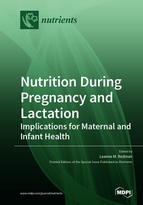Nutrition During Pregnancy and Lactation: Implications for Maternal and Infant Health
A special issue of Nutrients (ISSN 2072-6643).
Deadline for manuscript submissions: closed (28 February 2019) | Viewed by 89711
Special Issue Editor
Interests: obesity; calorie restriction; dietary interventions; overfeeding; pregnancy; gestational diabetes; breast feeding; infant formula
Special Issues, Collections and Topics in MDPI journals
Special Issue Information
Dear Colleagues,
Pregnancy is a viewed as a window to future health. With the birth of the developmental origins of human adult disease hypothesis, research and clinical practice has turned its attention to the influence of maternal factors such as health and lifestyle surrounding pregnancy as a means to understand and prevent the inter-generational inheritance of chronic disease susceptibility. Outcomes during pregnancy have long-lasting impacts on both women on children. Moreover, nutrition early in life can influence growth and the establishment of lifelong eating habits and behaviors.
Maternal nutrition is probably one of the most well described factors known to directly impact fetal development and infant health. For example, inadequate folate intake in mothers who gave birth to children with neural tube defects led to studies on folate supplementation, widespread food fortification programs and clinically to the routine prescription of vitamin and mineral supplements to pregnant women. In the modern world, pregnancy and lactation is now plagued by new challenges brought about by poor quality diets irrespective of their energy content. Dubbed the double burden of malnutrition, the maternal diet can influence the healthy progression of pregnancy. For women, the maternal diet in pregnancy can influence the likelihood of gestational diabetes and gestational hypertension disorders. For children, a mother’s diet can influence size at birth and lifelong progression for obesity, type 2 diabetes and cardiovascular disease. New research is emerging on the unique role the maternal diet can have on breastmilk, influencing the nutritive and non-nutritive components which not only impacts normal growth but susceptibility to allergies and asthma.
Efforts have been made to improve the quality and quantity of the maternal diet in pregnancy and during lactation to alter the downstream implications on maternal and child health. Approaches while varied most often times result in an improvement in diet quality yet studies vary in their impacts on adverse pregnancy outcomes and child health. New research that investigates the influence of specific dietary components, maternal eating attitudes and behaviors and the interactions with the gut microbiome is needed to advance our understanding of maternal nutrition during pregnancy and lactation to optimize health outcomes of women and children.
This Special Issue on “Nutrition during Pregnancy and Lactation: Implications for Maternal and Infant Health” is intended to highlight new epidemiological, mechanistic and interventional studies that investigate maternal nutrition around the pregnancy period on maternal and infant outcomes. Submissions may include original research, narrative reviews, and systematic reviews and meta-analyses.
Dr. Leanne M. Redman
Guest Editor
Manuscript Submission Information
Manuscripts should be submitted online at www.mdpi.com by registering and logging in to this website. Once you are registered, click here to go to the submission form. Manuscripts can be submitted until the deadline. All submissions that pass pre-check are peer-reviewed. Accepted papers will be published continuously in the journal (as soon as accepted) and will be listed together on the special issue website. Research articles, review articles as well as short communications are invited. For planned papers, a title and short abstract (about 100 words) can be sent to the Editorial Office for announcement on this website.
Submitted manuscripts should not have been published previously, nor be under consideration for publication elsewhere (except conference proceedings papers). All manuscripts are thoroughly refereed through a single-blind peer-review process. A guide for authors and other relevant information for submission of manuscripts is available on the Instructions for Authors page. Nutrients is an international peer-reviewed open access semimonthly journal published by MDPI.
Please visit the Instructions for Authors page before submitting a manuscript. The Article Processing Charge (APC) for publication in this open access journal is 2900 CHF (Swiss Francs). Submitted papers should be well formatted and use good English. Authors may use MDPI's English editing service prior to publication or during author revisions.
Keywords
- Pregnancy
- Pre-conception
- Nutrition
- Diet
- Diet quality
- Intervention
- Gestational weight gain
- Gestational diabetes
- Childhood obesity







